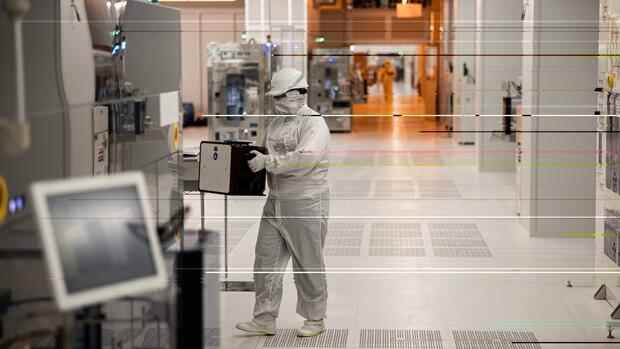Munich Two locations, one virtual factory: Infineon has digitally interwoven its plants in Dresden and Villach. Europe’s largest chip manufacturer drove this complex project forward for several years. With the opening of the new production facility in Carinthia, the company now hopes that the high investments will pay off.
The engineers have harmonized the machines in the two locations to such an extent that they are treated as a common digital factory. Customers and investors should now benefit from this. “We are more flexible, produce more cheaply and can bring new products to market more quickly,” said Jochen Hanebeck, Board Member for Production, to the Handelsblatt.
The project is important in order to fulfill one of the central promises to the shareholders: the operating margin should be an average of 19 percent in the future. A value that the group has not even come close to achieving in recent years and which CEO Reinhard Ploss missed even in the exceptionally good financial year that has just ended, which ended on September 30th – it was 18 percent.
In addition, Ploss has announced strong growth: In the long term, Infineon is expected to achieve an average of nine percent growth in sales per year – significantly more than experts for the entire chip industry expect.
Top jobs of the day
Find the best jobs now and
be notified by email.
In September, Infineon officially inaugurated its latest plant in Villach. The company is investing 1.6 billion euros in the new building at the existing location. The production is similar to that in Dresden: “The two factories have exactly the same systems, we use the same IT applications and have developed common standards,” says Hanebeck.
Infineon expects noticeably lower costs through economies of scale in purchasing. The expensive machines, according to the plan, will also be better utilized from now on. The teams from Saxony and Carinthia should also work more closely together and thus become more innovative. And: “Villach and Dresden should grow faster with the One Virtual Fab than would be possible for the two locations alone,” says the headquarters in Munich.
A power failure brought the Infineon plant to a standstill for a short time
The virtual factory also offers another advantage: in the event of a disaster, production does not collapse completely, only in part. “The recent power failure in Dresden has shown how important different locations can be,” emphasized Hanebeck.
In September, the power supply on the Elbe was interrupted for 20 minutes, and production was briefly shut down. The company has not yet commented in detail on the consequences. In the spring, an Infineon factory in Texas had been idle for days due to a snow storm, which led to massive delivery problems.
Infineon leaves it open exactly how expensive the virtual factory project is. Just this much: Aligning the 400 IT applications alone cost 30 million euros. Chip production is complex: it takes several hundred steps and months before a component is finished.
Infineon produces power semiconductors at the two locations. They represent a good half of the Group’s sales, which amounted to eleven billion euros in the past financial year. These components account for almost ten percent of the entire chip market; in 2020 it was 46 billion dollars.
300-millimeter wafers: Infineon produces power semiconductors on these wafers in Dresden and Villach.
(Photo: dpa)
Power semiconductors are becoming more and more important for many customers because they convert the electrical energy provided into the form required by the consumer. They are installed in power supplies, in servers, notebooks, medical devices or even in electric vehicles.
For example, they are used for frequency converters, i.e. for electronic devices with which the speed of electric motors can be changed electronically. Or for converters in solar power systems. These convert the direct current from the photovoltaic modules into the normal alternating current and feed this into the public grid.
In the next five years, Infineon intends to increase sales of power semiconductors by half. The costs should fall by a fifth in the same period. The virtual factory contributes to this – and so does the production on 300 millimeter large, particularly thin silicon wafers. Infineon is the pioneer in this technology. So far, 200 millimeters has been common in industry.
The industry association ZVEI estimates that the automotive industry alone will buy power semiconductors for 38 billion euros in 2030, a good four times as much as today. According to a current study by the ZVEI, 17 additional factories are required for this. In addition, six new plants worldwide are needed for other industrial customers and for renewable energies. It is therefore quite possible that one day additional Infineon locations will complement the virtual network of Villach and Dresden.
Investors are extremely satisfied with Infineon
“The next virtual factory could be built between Villach and Kulim,” explained Hanebeck. Infineon operates a large plant at the location in Malaysia. However, this would not combine the production of power semiconductors, but the production of so-called semiconductors with a wide band gap, according to Hanebeck.
Investors are currently extremely satisfied with the way Infineon is developing. The share price is quoted at just under 38 euros, the highest level in two decades. Business is going well: Sales are expected to increase by 15 percent in the fiscal year that has just started. At the same time, the operating margin will climb to 20 percent if the latest forecast comes true.
Infineon’s biggest problem at the moment: For months now, the company has not been able to deliver as much as its customers would like. The digitization surge triggered by the pandemic is generating huge demand throughout the industry. The fact that emissions are now increasing with the virtual factory is therefore worth real money. Because some customers are even willing to pay moon prices, CEO Ploss recently revealed.
More: Europe wants to fight the chip shortage – and is blocking itself
